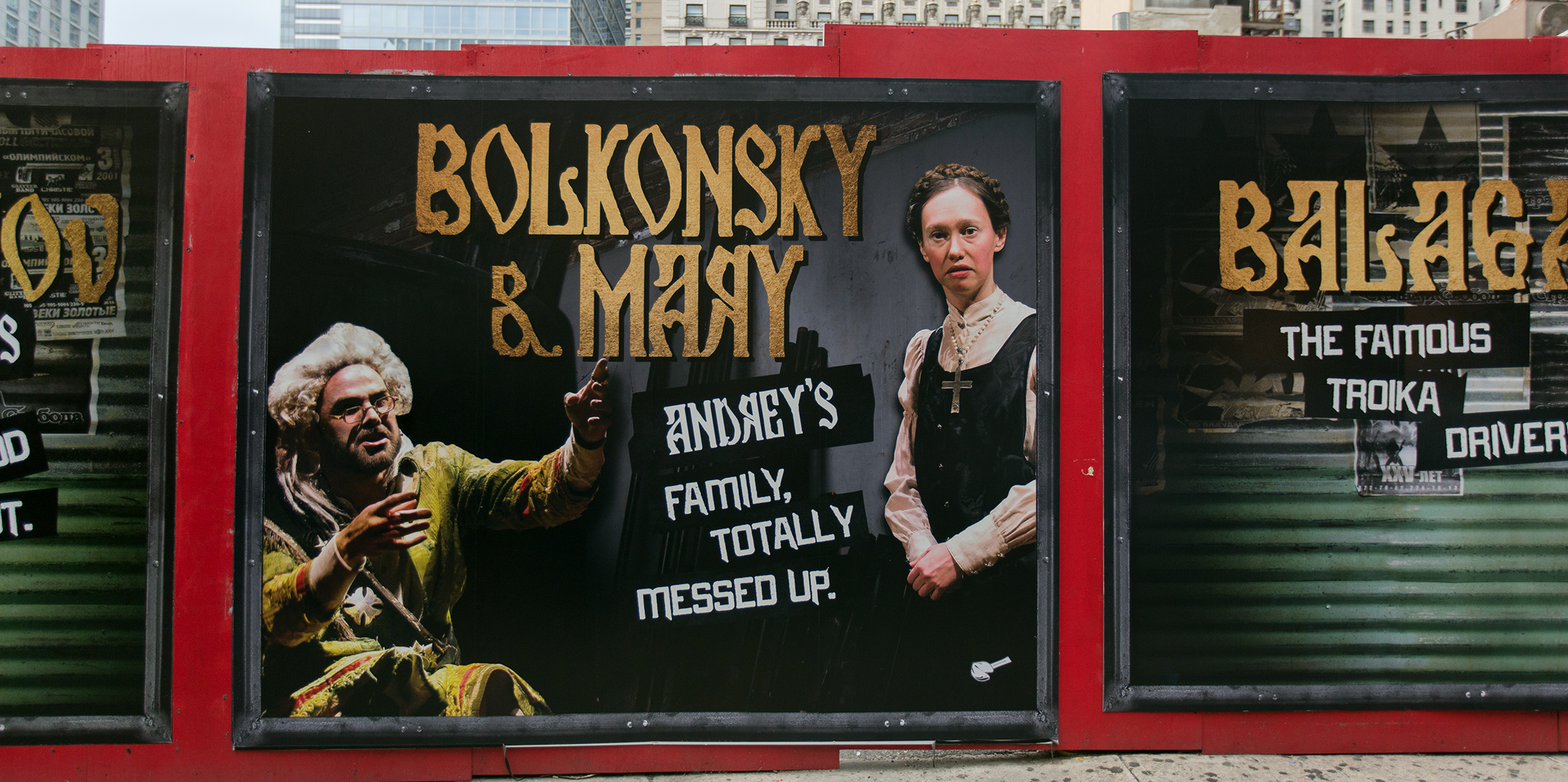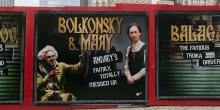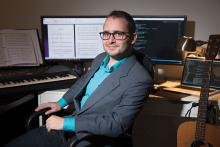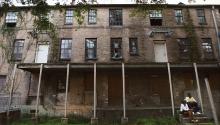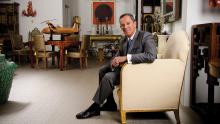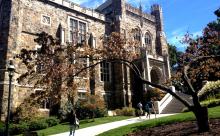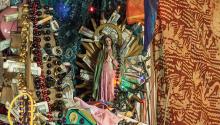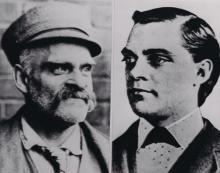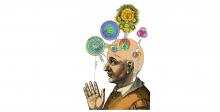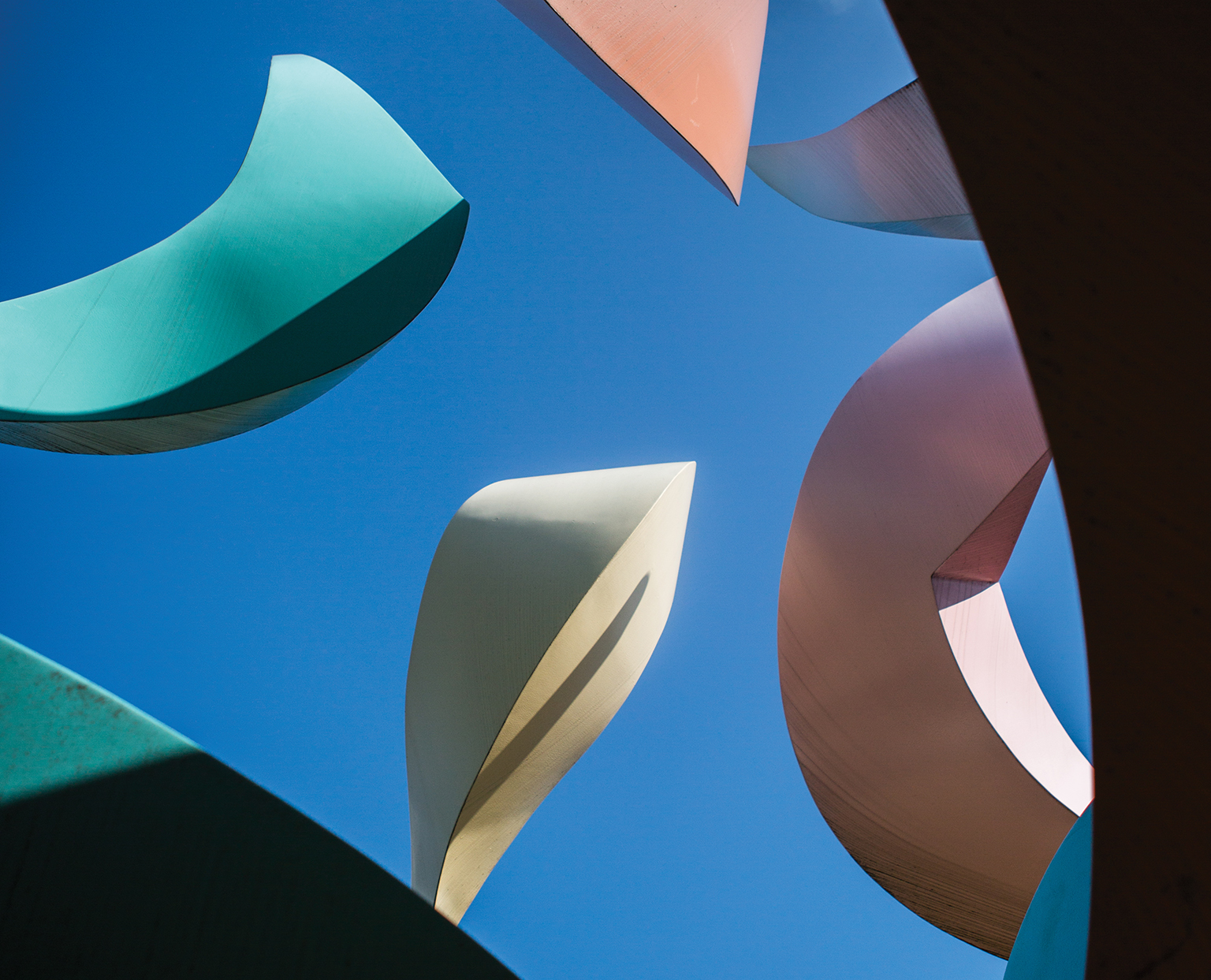
According to all public accounts, the official groundbreaking for Zoellner Arts Center, currently celebrating its 20th anniversary season, took place on April 7, 1995.
Only a handful of people are aware that the ground was actually broken a few nights before.
“Just before the ‘official’ groundbreaking for Zoellner Arts Center in the spring of 1995, Bob Thompson, (music department chair) Nadine Sine and I made our way to the future site of the arts center,” recalls Deborah Sacarakis, Zoellner’s artistic director. “In a late-night, impromptu ceremony, we dug a little hole in the earth with a spoon and declared the location duly dedicated to arts. Dr. Sine is still in possession of the ceremonial spoon. The potential envisioned for the center was invigorating and inspirational.”
Sine says: “The spoon with a carefully typed label commemorating the event still sits in my office.”
This incident actually speaks volumes about the resourcefulness, tenacity, ingenuity and imagination that characterized the arts at Lehigh University in the decades before Zoellner Arts Center.
“Without question, there was an active and remarkable cultural life at the university prior to the construction of the center,” Sacarakis says. “Performances, however, were staged in the old dining room in Lamberton Hall, in Wilbur Powerhouse, in Grace Hall, in the Asa Packer Dining Room, in Packard Lab Auditorium, in Whitaker Lab Auditorium, in Broughal Middle School, in just about any space that could be ‘adapted’ to accommodate a performance.
“Staging performances was daunting and difficult,” she says. “At most of these venues, the stage had to be built, folding chairs set out, lighting and sound instruments loaded in and set up, dressing rooms jerry-rigged. I think both artists and audience members made allowances for less-than desirable venues. That was to the credit of both groups. “After Zoellner was inaugurated, professional staff including technical support, box office and marketing personnel took over for student and subcontracted personnel who were engaged on a show-by-show basis,” she says.
Fostering Creativity
Indeed, Zoellner Arts Center facilitated a whole new level for performances and presentations at Lehigh University. The 105,000-square-foot facility on Lehigh’s Asa Packer Campus, which is home to the department of music, the department of theatre, the art galleries and the guest artist series, officially opened for the 1997-98 season, with construction taking place the year before. Funded by a $6 million gift from the late Robert E. Zoellner ’54, the building was designed by Philadelphia architectural firm Dagit Saylor and houses three theatres: a 1,000-seat proscenium theatre (Baker Hall), a 300-seat thrust theatre (Diamond Theatre) and a 125-seat black box theatre. It also contains a two-story art gallery, several rehearsal rooms, a recording studio, dance studio, scene shop, costume shop, dressing rooms and green room, practice rooms, classrooms, a music library, box office, faculty and staff offices, and three large lobbies suitable for receptions. A 345-car parking deck is attached to the center.
There was no Zoellner Arts Center when Erica Hoelscher, who is today the chairperson of Lehigh’s department of theatre, came to Lehigh as a visiting professor in August 1995.
“When I first arrived at Lehigh,” Hoelscher recalls, “the Zoellner Arts Center was a large hole in the ground. Shortly after, the entire department faculty and staff put on hard hats and came over to tour the foundation and initial construction of the building. I remember standing in the audience area of the Diamond Theatre in awe of how much it resembled an ancient Greek theatre. Later, when we first moved into the building, I frequently would get lost in the lower level, where the costume shop is located.
“As the faculty member specializing in costume design, it was my job to pack the entire costume inventory that was stored in the attic of Chandler-Ullman and organize it in Zoellner Arts Center. I was also responsible for outfitting the Zoellner costume shop in terms of tools, machinery and equipment. It was a very exciting time because we were venturing out in new territory and were recipients of considerable investment on the part of the university,” she says.
Hoelscher emphasizes that theatre has always been an important aspect of the Lehigh education, dating back to the days when the university’s students were exclusively male engineers. In 1884, those students created the Mustard and Cheese Drama Society, writing, producing and performing plays at Lehigh and even touring the surrounding community.
Far from Renning’s Bar
Students were instrumental in bringing theatrical professionals to Lehigh University to advise the M&C Drama Society and advocated for theatre to be recognized as a valuable academic pursuit, complementing the other areas of study available at Lehigh.
Sine first came to Lehigh in 1980, becoming department chair in 1992, which she describes as “the moment when the university first gave serious consideration to building an arts center. We worked very hard to make it a reality. It was an exhausting process but worth every bit of it.” Zoellner has totally transformed the music department, according to Sine, who has remained department chair for all but three of the past 25 years (except for the 2006-09 period).
“While we did some excellent work in our old quarters in Lamberton (Hall), having such a wonderful, acoustically superior concert hall has put us on the map in the Lehigh Valley region,” she says. “We have used Baker Hall in every possible configuration, including some the architects never envisioned.
The faculty has nearly doubled in size, and hundreds of students are participating every semester, even though we have few majors. That we are able to do high-level performances with non-majors is a testament to the dedication of the students and the top-notch faculty who direct them.
“Those of us who were around in the days before Zoellner can attest to the impact the center has had on the entire campus. It gave the arts a visible presence, and all the activity there has provoked an entirely new atmosphere throughout the university,” she says.
From a numbers perspective, Zoellner’s impact on the department of theatre is clear. Since 1996, Hoelscher says, student enrollment in theatre department courses has increased 64 percent, and since the department moved to Zoellner, the number of students involved in theatre productions has tripled to more than 1,500 students per year.
“The department of theatre’s long-term commitment to diversity is reflected in our productions, one-quarter of which are plays highlighting minority themes, marginalized or alternative voices,” she says. “Our graduates pursue further studies at top-tier institutions, such as Yale, NYU, Brandeis, Columbia and Northwestern, or enter the industry in the country’s most competitive markets. “Lehigh theatre alumni are working in television, film and theatres across the United States, as well as in other professions, such as education, law, business, arts administration and public relations. Many of our graduates leave Lehigh to pursue professional and doctoral degrees from the most prestigious educational institutions in the country,” Hoelscher says.
Sine says one of her earliest memories of Zoellner is a sensation of calm that came over her while standing in the balcony during the first rehearsal in Baker Hall in January 1997.
“I was feeling a wave of relief upon hearing the wonderful acoustics in the hall,” Sine recalls. “Having great acoustics is never a given in even the most celebrated venues and cities, so it was joy to hear the music in our new hall.”
For Sine, the stellar Baker Hall acoustics also bring to mind a particular guest artist event—a Zoellner gala performance by Tony Bennett. Few can forget “the moment in which he put the microphone down and sang without amplification. It was another testament to the wonderful acoustic of Baker Hall,” Sine says.
Andy Cassano, who became part of the Zoellner team in the fall of 2012, says it’s difficult to name the most notable Zoellner performers or performances that have occurred so far during his tenure as administrative director, but he also lists Bennett’s “mic drop” among the most memorable.
“Oh goodness ... that’s hard,” Cassano says. “I could tell you about when Arturo Sandoval came here and gave one of the best performances I have ever heard. I could tell you about when Kristin Chenoweth walked out for her show with a 40-ounce Wawa soda and said, ‘It’s good to be home’—part of her childhood was in Pennsylvania—and instantaneously connected with 1,000 people before singing one note.”
As administrative director, Cassano oversees all the organizational functions at Zoellner and all of its 250-plus annual events. That includes leading the staff who service all the technical, production and audience services, marketing and advertising, fundraising and finance as well as coordinating with the artist director and the guest artist series.
Hoelscher says she hopes that Zoellner Arts Center will have an even more central role at Lehigh in the future.
“Creative inquiry is now an important avenue of cross-disciplinary study at Lehigh, and the department of theatre has long been associated with interdisciplinary pedagogy,” she explains. “I hope that the university will see the wisdom, practicality and marketability of educating students with the ability to work in a team, appreciate philosophical, ideological and political perspectives that differ from their own, who are innovative, imaginative and empathetic, and who value diversity and collaboration. All of those area skills that can be acquired through participation in the arts.”
Looking Ahead
Visioning the center’s next 20 years, Cassano says that Zoellner’s ultimate value to Lehigh and the surrounding community will likely extend far beyond the artists trained inside the building’s classrooms.
“We train artists, we develop artists, and we are—at our core and primary focus—about the art,” he says. “But what we also do well, perhaps even better, is train advocates, leaders and the next generation of audiences. Music and theatre have about three to four dozen majors. But every year, we have about 1,000 students from all four colleges who participate in performances, in design, technical and audience services. They find their passion in the arts at Lehigh. They find how to use their creativity in the arts in their academics. They find their outlet for expression in performance. They also connect with their passion through their experiences in attending transformational events. These are the next generation of leaders who will hopefully go into their communities and have the arts as a part of their lives.”
“Zoellner Arts Center still has a lot of potential to make a bigger impact,” he says.
Zoellner has been, and will continue to be, a part of a rich cultural heritage in Bethlehem and the Lehigh Valley, according to Sacarakis.
“As recorded by the early Moravians,” she explains, “Bethlehem residents were creating and recreating music, literature and other arts in the 1700s. In that regard, Lehigh University Choral Arts fits into the long and great tradition of singing that predated the city’s founding. Similarly with orchestral work, the early Moravians had one of the nation’s first orchestras, and we continue that tradition with the Lehigh University Philharmonic. “With the construction of Zoellner, the aesthetic of the venue finally came closer to matching the aesthetic of the productions and art being presented,” she says. “It’s always a pleasure and interesting to welcome back to campus, alums who have participated in the performing arts at Lehigh and to share with them performances in our beautiful center. Whether those students graduated before the center opened in 1997 or after, they are part of the Zoellner Arts Center story. There are many dedicated alumni, faculty, administrators and staff members—some no longer with us—whose work built a strong foundation and whose generosity enabled the vision to be realized. They are all part of Zoellner Arts Center’s living legacy.”
Sacarakis says that she has come to view Zoellner as “the heart” of the Lehigh campus.
“It’s pretty unbelievable when I take time for recollection and reflection. It is still exciting and inspirational,” she says. “I can only hope that, as Tony Bennett sang on stage at Zoellner Arts Center (fall 2011), ‘The Best Is Yet To Come.’”

